More people in employment in Caribbean Netherlands in 2024
In the Caribbean Netherlands, the employed labour force (aged 15 to 74) increased to 17.5 thousand in 2024. That was an increase of 12 percent compared with 2022. There were more people in work in Bonaire, in particular. Saba also saw an increase, although it was relatively modest. In St Eustatius, the number of people in work decreased. This is according to the most recent Caribbean Netherlands Labour Force Survey, conducted by Statistics Netherlands (CBS).
In Bonaire, the number of people in employment rose by 1.8 thousand (+14 percent) to 14.7 thousand in 2022. 73.8 percent of all those aged 15 to 74 were in employment. In 2022, the net labour participation rate in Bonaire was 72.5 percent. The net labour participation rate is the percentage of people aged 15 to 74 who are in work.
In St Eustatius, 1.8 thousand people were in employment, 3 percent less than in 2022. The net labour participation rate therefore fell from 72.9 percent to 71.4 percent.
In Saba, 67.2 percent of the population aged 15 to 74 years were in work. There were 1.1 thousand people in work, 90 more than in 2022.
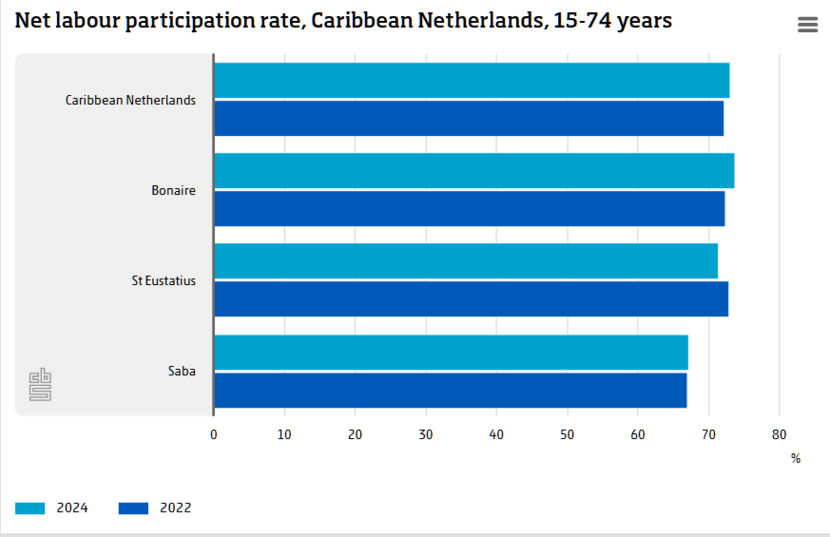
Increase in employment among both migrants and local people
The number of local people in employment in the Caribbean Netherlands increased by 1.1 thousand to 9.3 thousand from 2022 to 2024. This group is defined as working people born on any of the islands of the former Netherlands Antilles - i.e. the islands of today’s Caribbean Netherlands (Bonaire, St Eustatius and Saba) plus Aruba, Curaçao and St Maarten.
A further 8.3 thousand working people were not born on one of these islands [note]. That was an increase of 800 compared with 2022.
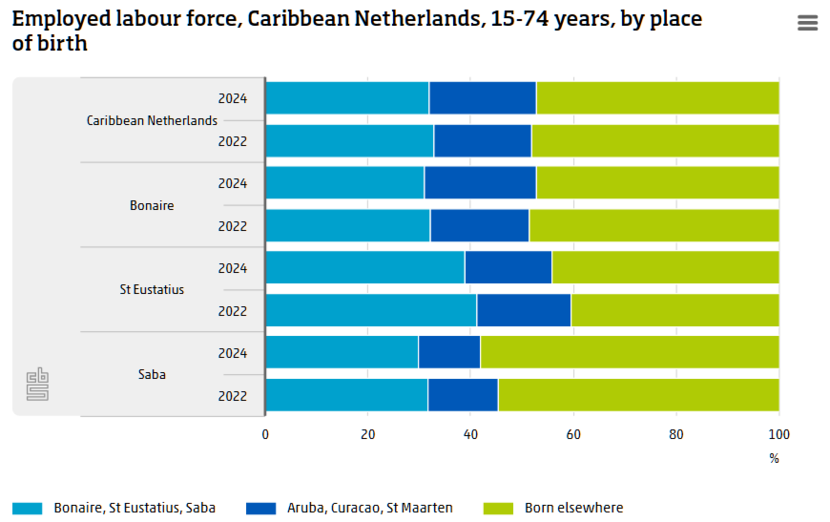
Relatively high growth in number of working people born outside Bonaire
In 2024, 10.2 thousand people working in Bonaire were not born on the island, 1.5 thousand more than in 2022. Of these, 20 percent were born in Curaçao and 15 percent in the European Netherlands.
Three in ten working people in Bonaire were people born on Bonaire. They were relatively likely to work in public administration and government services, health and social care, construction and trade. Compared to native-born Bonaireans, migrants were more likely to be working in construction and the hospitality sector (accommodation and food services).
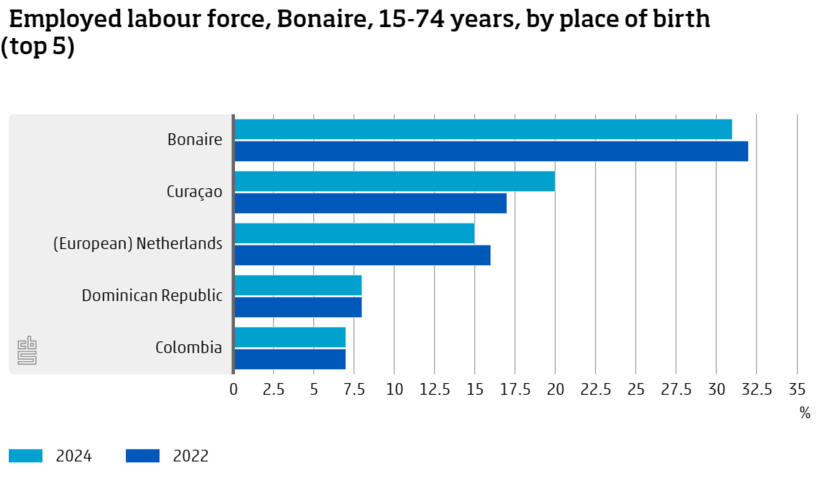
Many people from the Dominican Republic working in St Eustatius
37 percent of working people in St Eustatius were native-born Statians last year. In 2022, that share was 40 percent. They worked mainly in public administration and government services, in education and the manufacturing sector.
In addition to those born on St Eustatius, a relatively large group of workers were born in the Dominican Republic (14 percent). Migrants were more likely to work in construction than native-born Statians.
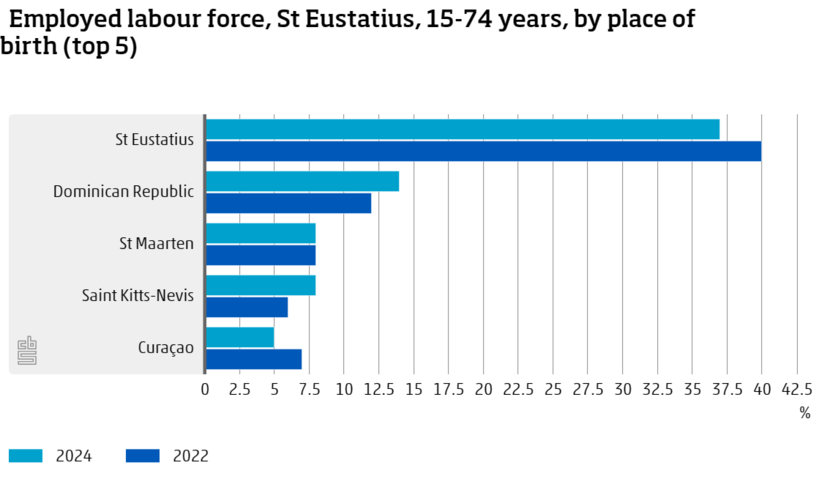
Share of working people in Saba who were born in Saba declines
Around 29 percent of the employed labour force in Saba were native-born Sabans. In 2022, that share was 31 percent. Nearly half of working Sabans (45 percent) were employed in public administration and government services.
Of all those in work, 780 were not born on Saba. In 2022, the number was 700. Around 1 in 10 working people in Saba were born in Colombia, for instance. Migrants were more likely to work in the construction, trade, hospitality and education sectors than native-born Sabans.
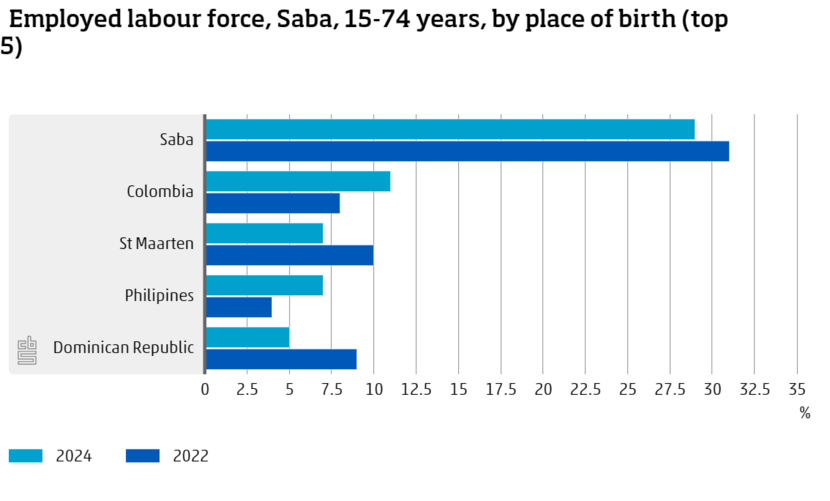
Sources
StatLine - Caribbean Netherlands; labour participation, key figures
https://opendata.cbs.nl/statline/#/CBS/en/dataset/83165ENG/table?ts=1751667328651
StatLine - Caribisch Nederland; Labour participation, country of birth (Dutch)
https://opendata.cbs.nl/statline/#/CBS/nl/dataset/83167NED/table?dl=C34CA
StatLine - Caribbean Netherlands; jobs and wages, economic activity (SIC2008)
https://opendata.cbs.nl/statline/#/CBS/en/dataset/82519ENG/table?ts=1751667444120
Relevant links
News - Number of employed in the Caribbean Netherlands continued to rise in 2022 | CBS
Note
Before an employer in the Caribbean Netherlands can hire somebody who is not a national of the Netherlands or the US, they are first required to make demonstrable efforts to find a suitable local employee or an employee who holds Dutch or US nationality.